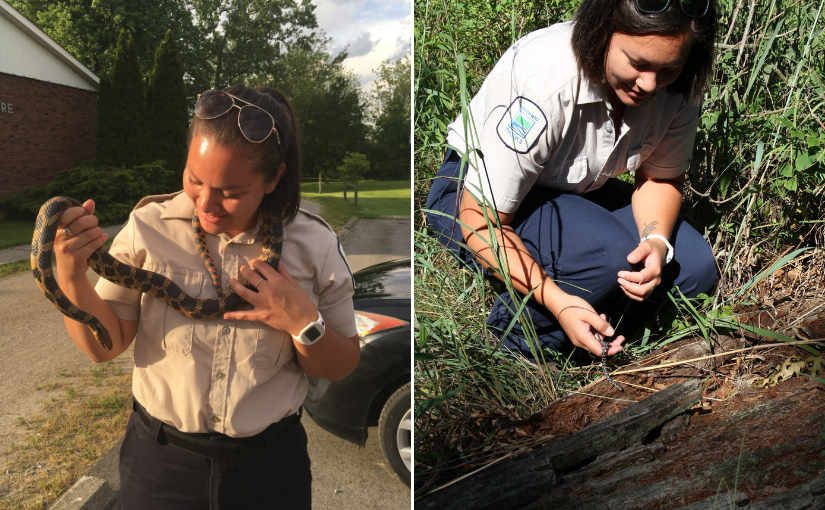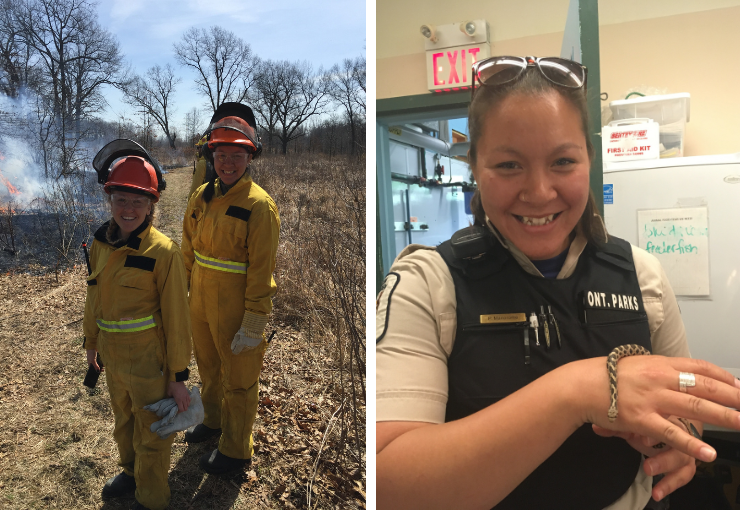Today’s blog was written by Pilar Manorome, a park planner in Protected Areas Section at Ontario Parks.
As a kid, I was always fascinated by the natural world around me and was very fortunate to grow up in Norfolk County.
It was a place where I could step out my door and have a wide array of trees, wildflowers, birds, insects, and everything in between, right at my fingertips.
I am also very blessed to have a family that encouraged exploration of the natural world through taking me to the local conservation areas and provincial parks to find frogs and wildflowers, and down dirt roads to find birds and butterflies.
Although my mom and grandparents lit the spark, the flame was truly fanned when I started volunteering for my local Conservation Authority.
Working for Ontario Parks has only further fed the fire.
Stepping into Ontario Parks
I started my Ontario Parks career as a senior park naturalist at a little park you may or may not have heard about: Killbear Provincial Park!
If you’ve never spent time enjoying the stunning vistas or sunsets, I encourage you to do so. It’s a very special place!
Although my Ontario Parks career started at Killbear, my broader parks career started in my local Conservation Area: Backus Heritage Conservation Area.
There, I volunteered and worked as a summer student at the Education Centre and in the Heritage Village as a naturalist and camp counsellor and began to build upon the natural history and cultural heritage knowledge that I was able to bring with me to Ontario Parks.
I was encouraged by the lead educator and ecologist at the time (now the senior zone ecologist for Ontario Parks’ Southeast Zone!) to apply for the Discovery roles she knew were available with Ontario Parks – and I took a shot.
And, WOW, has that shot worked out in a big way!
Taking a Tour de Parks
As a naturalist with Ontario Parks, every day is different from the day before.
For example, I remember days working at Killbear where I’d have a desk shift chatting with park visitors in the Discovery Centre, followed by leading or developing a program, interjected with a snake call (where we’d work to protect Eastern Massasauga Rattlesnakes and Eastern Foxsnakes by pit tagging them for research and relocating).
Then the day was capped off with doing some resource management activities such as managing invasive species or fixing reptile fencing along the roadside.
Since that amazing first day working for Ontario Parks, I’ve had the ability to work in a couple of different and very cool places (Rondeau Provincial Park, Algonquin Provincial Park, and East Sister Island Provincial Park, to name a few) and try many different roles within parks – from enforcement to ecology and finally into my current role as a park planner.
I believe a lot of the skills I gained during my time in the Discovery program set me up for a successful career with Ontario Parks.
But I think the most important was the ability to communicate and translate often technical information with visitors of all ages.
Once you’ve successfully delivered a children’s program and a guided hike or evening program in the same day or week, you can certainly excel at many different roles at Ontario Parks!
Fascinated by flora and fauna?
If you like to nerd out about birds, lichen, or wildflowers or share the cultural importance of an area, a role in Discovery is certainly for you!

And take my advice: it can open A LOT of doors (and a few random windows) you may have never expected.
Learn more about jobs with Ontario Parks and how to apply on our careers page.
Why are your scientists picking up wildlife? Can I pick up snakes and turtles too?
Please do not handle wildlife. The staff members featured here are trained scientists engaged in professional research. These scientists are following a strict animal care protocol approved by the Ministry of Natural Resources and Forestry. These protocols review the desired outcome of the research, and ensure measures are taken to put the least possible amount of stress on the animal. We ask that you always observe animals from a distance for both the safety of you and the animal.




